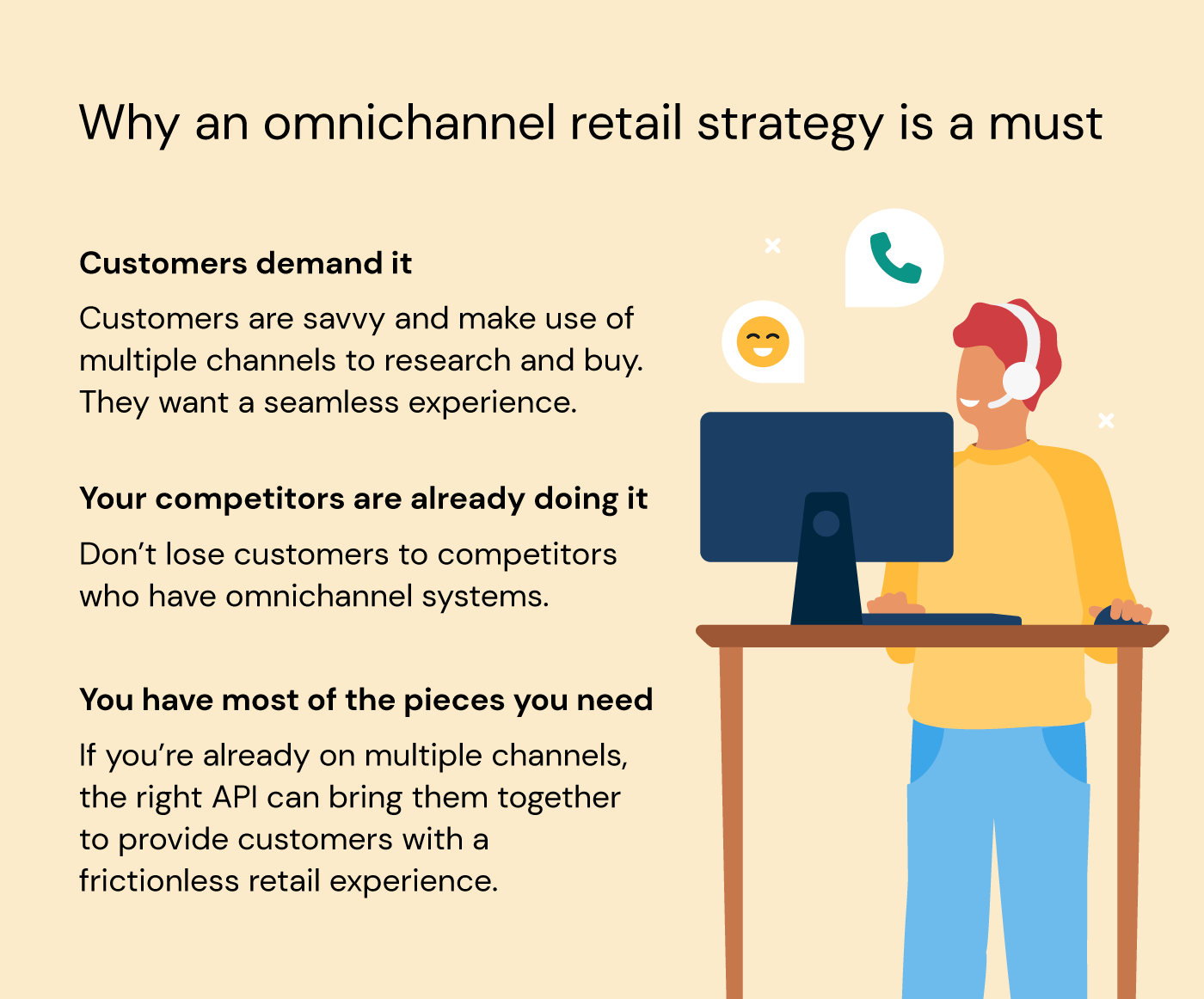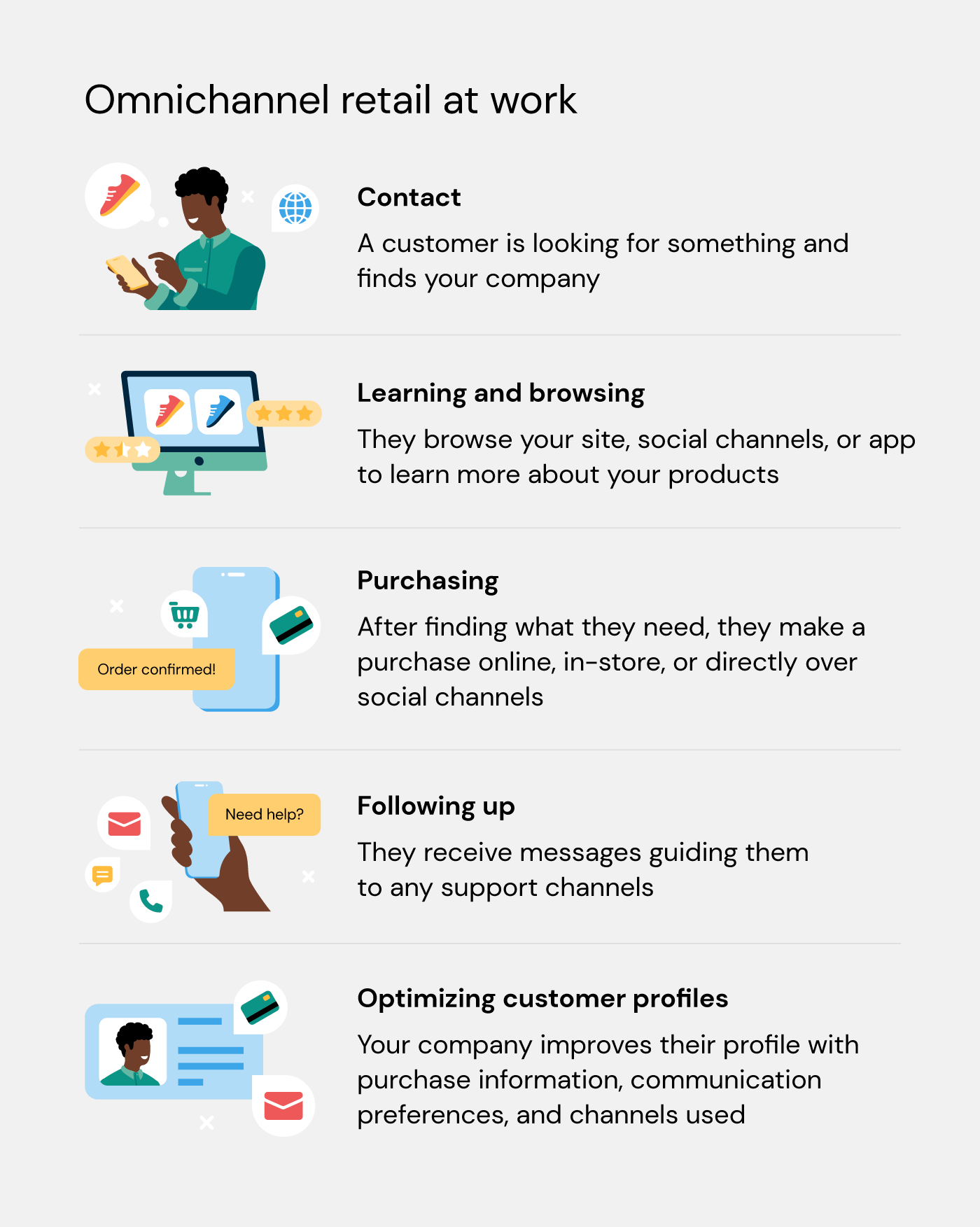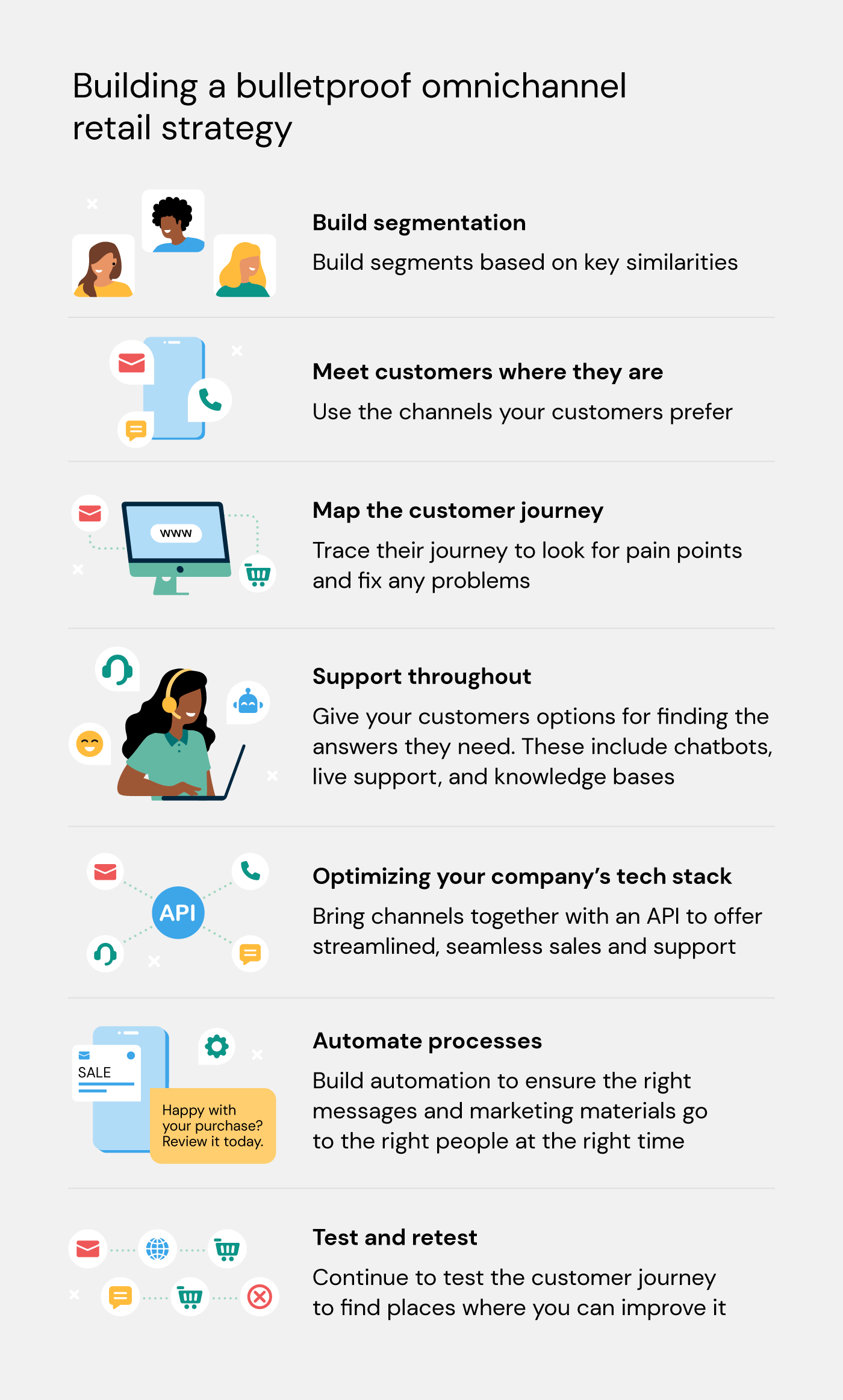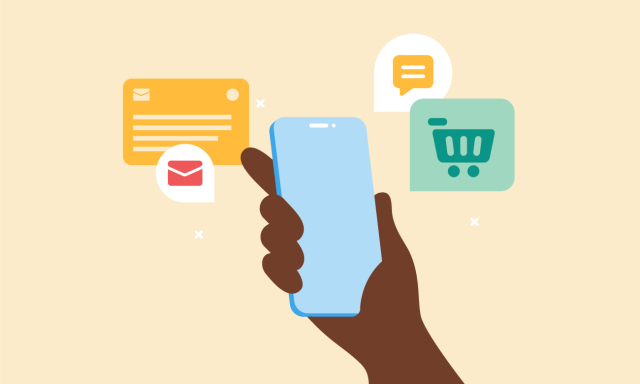The retail industry is changing, and the shift is being driven by consumers. The long-held belief that online shopping was a fad or merely for impulse buys is gone. With the continued growth of online retail and the shrinking of brick-and-mortar sales, everything seems to be pointing to an inevitable future where all shopping happens online. But that's not necessarily the case. There are now a bunch of ways to shop: welcome to the world of omnichannel retail.
But what is omnichannel retail? It’s an interconnected experience for the customer across in-store and online touchpoints, including:
- Social media
- Texts
- App
- Phone calls/voice
- Ads
Omnichannel retail is about streamlining the entire customer journey, from interest to purchase to ongoing support. Driven by powerful APIs that help channels work together, the customer’s information moves across channels to make selling and support as easy and frustration-free as possible.
But is omnichannel retail really here to stay or is it just a blip on the radar? A study conducted by the Harvard Business Review found that omnichannel shoppers spend more than those who only shop on a single channel. Their data shows that the more channels customers use, the more they will spend. With that kind of evidence, you can’t really ignore the importance of omnichannel retail trends.
What makes omnichannel retail different from multichannel
Because modern customers use a variety of channels when they are shopping, it’s crucial to offer sales and support on those channels. Omnichannel and multichannel strategies involve several channels; how they work together (or don’t) is what makes them different.
Multichannel retail
In a multichannel retail strategy, a company might have access to many of the channels its current and potential customers use.
But these channels don’t work together. For example, let’s say a customer visits your online store and signs up for an email alert when a specific product arrives. Later, they sign up for text messages so they will be notified when new products launch.
The customer will get the email about the product they wanted and they will get texts about your new launches, but they won’t get personalized text alerts for inventory notices or emails about new launches based on their interests. These separate text and email channels don’t talk to each other in a multichannel retail environment.
Your customers can get frustrated trying to find support across siloed channels, and it might even take sales away from your company.
Omnichannel retail
Imagine having an integrated approach to selling (and buying) where customers can move across channels and pick up where they left off.
Say a customer signs up for an email inventory alert for a specific product while browsing your online store. Later, they opt-in to text or WhatsApp messages for sales and other alerts. When the item is available again, they receive a text with a link to the item, along with an email. With Sinch’s Conversation API, you can even set channel priorities and fallbacks for each customer contact to message customers on their favorite channel, and ensure that messages are always delivered.
After they make a purchase, if they have a question about the item, they can text your company or engage via chat on your site and your agents will have access to their information, including their conversation history stored across channels.
That powerful and seamless web of channels is omnichannel retail.
Why you need an omnichannel system

Putting it bluntly, you need an omnichannel system because that is where commerce is headed. Research shows that people spend more with an omnichannel system, they have more loyalty and better engagement with your brand, and you reduce customer churn.
Soon, customers will expect personalized experiences from every business they use. And why shouldn’t they? Who doesn’t want a frictionless experience between an app, or a business’s social channels, and a brick-and-mortar store? Who wouldn’t love getting recommendations based on what you actually looked at and bought? And as a business, don’t you want to have more actionable data on your customers and better inventory management?
Omnichannel retail examples of strategy at work

To give you an idea of how an effective and efficient omnichannel retail strategy works, we’re going to discuss a hypothetical retail brand - Shoes and Socks Unlimited. Along with the brand, we’ll talk about the touchpoints this brand has with a single customer, how those touchpoints can improve the likelihood of a sale, and how the omnichannel strategy will keep them coming back.
Initial contact
The Shoes and Socks Unlimited name has been out there for a while, so there’s some brand recognition and the company has invested in marketing across a number of digital channels.
One day, a customer searches for a new pair of hiking boots and comes to the website by clicking on a link that highlights a brand of hiking boots sold by Shoes & Socks Unlimited.
If they’re already a customer, an omnichannel system allows the company to use data collected from previous interactions to develop a better profile based on this new search behavior. This lets the company send more personalized and useful marketing materials to this customer in the future.
Browsing and learning more
When the customer clicks on the link and is brought to the site (or the Shoes and Socks Unlimited app) and starts looking at the available hiking boots, a chatbot pop-up offers help.
The company designed this chatbot to ask for information like shoe size, brand preferences, and favorite outdoor activities to show some quickly personalized options to the customer. The chatbot could offer to create an account for the customer so their information and preferences get saved for next time. It can also let the customer know that it can check on product availability at its nearest brick-and-mortar location – a feature that 92% of people surveyed by Sinch said they would like.
After a certain period of time spent on the site - or after the customer visits a certain number of products or pages - the company could offer a coupon pop-up if the customer signs up for an email newsletter or texts. If the customer browses via an app, then an in-app push notification can offer the same personalized message.
Making the purchase
The customer finds the perfect pair of boots and buys them. During the purchase, they receive options for how they want to receive their new pair of boots:
- Traditional delivery
- Expedited delivery
- In-store pickup
After they decide, the Shoes and Socks Unlimited system sends a confirmation email and a message over a designated channel (if the customer opted in during the checkout process) when the item is shipped, delivered, or ready to be picked up.
Following up on the purchase
Because the Shoes and Socks Unlimited omnichannel system is working seamlessly, they’ll know when the customer received their new pair of boots. Receipt of the item then triggers some next steps for the customer:
- They receive a text or social media message offering ongoing omnichannel customer support, including a quick way to return or replace the boots and a link to any warranty or guarantees that Shoes and Socks Unlimited offers.
- After several weeks, the customer gets an email asking how the boots are working. The email asks them to review their purchase and fill out a satisfaction survey.
Optimizing their profile
Using the information that the customer provided to Shoes and Socks Unlimited, the company updates that customer’s profile. This includes information about shoe size, interests, the brands they prefer, and anything else that could help the company offer support or personalized marketing materials. With Sinch's unified API, companies can also get built-in analytics and track how separate channels they’re using are performing, including which are most used by customers.
How to make an omnichannel strategy that revolutionizes your customers' journey

Creating an omnichannel retail experience doesn’t happen overnight. The work you’ve done on separate channels won’t go to waste when your company decides to go the omnichannel route.
One of the main goals of the omnichannel system is to share information across channels in order to let your customers (and your agents) pick up where they left off. Here’s how to make their new journey happen.
Create segments that reflect your customers
As with any strategy that aims to improve the customer journey, it starts with the creation of accurate and useful segments. By identifying key groups, you can serve your customers better.
Look for similarities in demographics, income levels, geography, job type, and other characteristics that will allow you to know who your customers are and adapt it for each market.
One great example of segmentation done right comes from Cdiscount, a European company with a number of online markets that wanted to improve conversions on their marketing campaigns. While Cdiscount had used SMS for a long time, they weren’t seeing the results that they’d hoped for. By focusing on a segment of their customer base (210,000 of over 9 million total customers), they were able to create exciting RCS messages that featured dynamic CTAs, images, and videos. They saw a 4% jump in revenue and the average cart size increased by 9%.
Look at how your customers are finding you
The next part of the journey is how the customer found you. By determining where your customers are coming from, you can attach that information to segments to further refine their journey. It’s easy to forget about this or to put other characteristics ahead of channel choice, but different channels require different marketing and support strategies.
Often, the channel someone uses can provide you with a ton of information that makes segmentation easier. For example, you probably won’t have a lot of customers in their 50s and 60s who use Telegram, but they will be more likely to call a brick-and-mortar location than a 20-year-old.
Draw up a map of their journey
When you’re drawing up a map, the best thing you can do is not make assumptions.
Start with the how and why:
- How is the customer getting to you?
- Why are they looking for the thing you’re offering?
Mapping a journey may not be a straightforward process. Customers may start their searches wide, doing research on product categories and brands more than on specific products or services. Some people sign up for email lists, look at different brand websites, and check for reviews and recommendations.
As customers move along their journey, learning more about what they need and how they interact with the brand can take on different forms, both online and offline. While they may not communicate it directly, many people search for brands that have an omnichannel strategy because it allows them to walk away and pick up where they left off when the time is right.
Once you see the journey that your current and potential customers take to get to your offerings, you can give them the help they actually need instead of the help you assume they need.
Provide support at each touchpoint
Support is one of the most vital parts of an omnichannel retail strategy because customers may need it at every step of their journey. Chatbots, live chat, phone support, email support, and knowledge bases are all important methods of providing support.
Customers actually want these kinds of support, too. In a survey, Sinch found that 90% of people want to get support or ask questions when messaging a business. That survey also found that 83% of people thought that rich messages, like video tutorials, are useful. These ‘rich media conversations’ aren’t commonplace yet, but customers are interested in them and can see how helpful they are. If your business can provide this type of support before your competitors do, you’ll gain a distinct advantage.

Each type of support is best suited to serving people at a particular part of their journey, but won’t necessarily be used in the “proper” order. That means having omnichannel customer service is more important than ever because it lets people move seamlessly between support methods as needed without frustratingly having to repeat key information.
Merge your tech stack for seamless service
Even if your company has several different channels, you're only working with a multichannel system until all of the channels are working together. Merging them into an omnichannel retail system requires an API that can handle everything and lets you and your staff easily respond to customer needs. Sinch’s retail solutions are designed to work across more than 16 channels to help you turn talk into sales.
Automate repeatable processes
Automating repeatable processes saves your company time and money and helps prevent lost opportunities. For customers, these automated processes get them what they need when they need it.
Look at the questions you get asked most often and build support around those queries. You can set up knowledge bases and chatbots to answer most questions for your customers. Live support is there if your customer can’t find specific answers - or if talking to a person would solve their problem faster.
You should also automate the things customers expect:
- Shipping notifications
- Account alerts
- Deals
- Abandoned cart notifications
A good rule of thumb is to look at what the companies with the best reputation for support and sales are doing and apply those practices to your company. You can also look at what you expect out of the businesses you buy from and see where you are falling short.
While automation is great, it’s also important for customers to be there for the 60% of people who want access to a live agent. With Sinch’s messaging products, you can make two-way conversations across channels seamless and easy.
As a leader in fashion, Zadig&Voltaire had the followers (nearly 1 million on Instagram) but they didn’t have the level of customer care that a luxury brand should. While there was some automation on Instagram, most queries were answered with a message telling the customer to reach out on another channel. By integrating Contact Pro, they created better chatbots to help customers while tracking messages unrelated to orders. Contact Pro is easily scalable, which was great for Zadig&Voltaire as engagement has increased on Instagram.
Test everything often and fully
Don’t expect everything to work perfectly every time. That's why testing is so valuable. Without testing, you may never see where you have inadvertently created extra pain points or forgotten key pathways your customers use on their journey.
Regular testing is the best early warning system you can use. As channels change and customers’ needs shift, having the foresight to head off problems will keep your customers happy and loyal.
With the right API, not only can you get insights and analytics more easily but you can also future-proof your business against new, unforeseen needs and market shifts.
Welcome to the future of omnichannel retail
The future of omnichannel retail is here. Are you ready for it? If creating or optimizing omnichannel customer service for your retail operation is at the top of your list of priorities, Sinch is ready to make it as simple and scalable as possible.
With Sinch’s range of products and services on your side, you’ll be able to integrate your retail, marketing, and support systems in ways that will keep up with the demands of your customers. To learn more about the ways that omnichannel will redefine retail, and how you can better engage with your clients, download Sinch’s report.
Looking into CPaaS providers? Wondering which vendors are best positioned to support your present and future communications use cases and what you should consider when choosing a CPaaS solution?
Get a copy of the 2023 Gartner® Magic Quadrant™ for Communications Platform as a Service (CPaaS) to find out.




